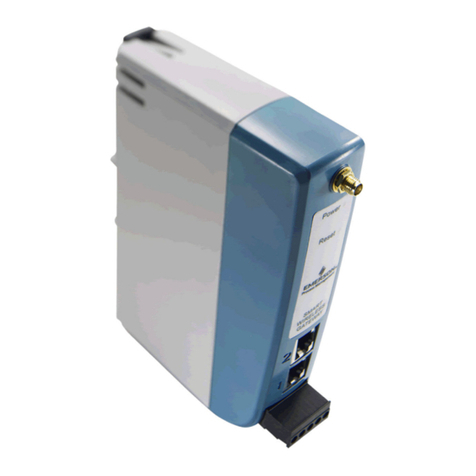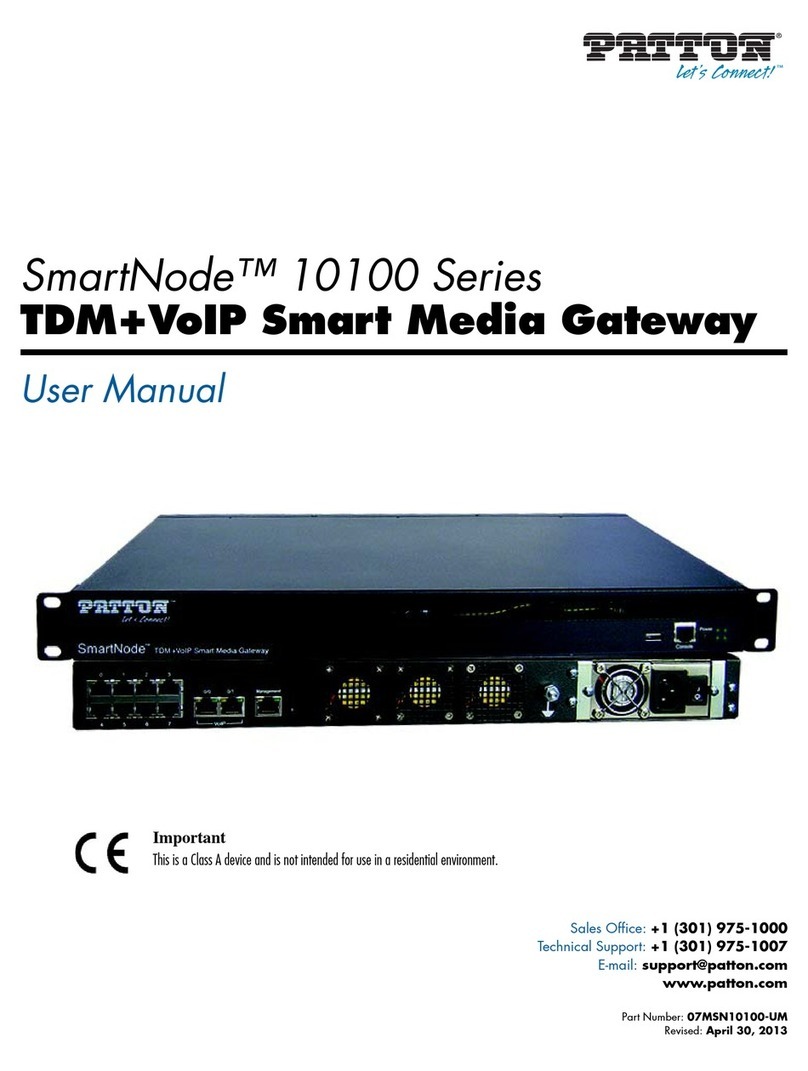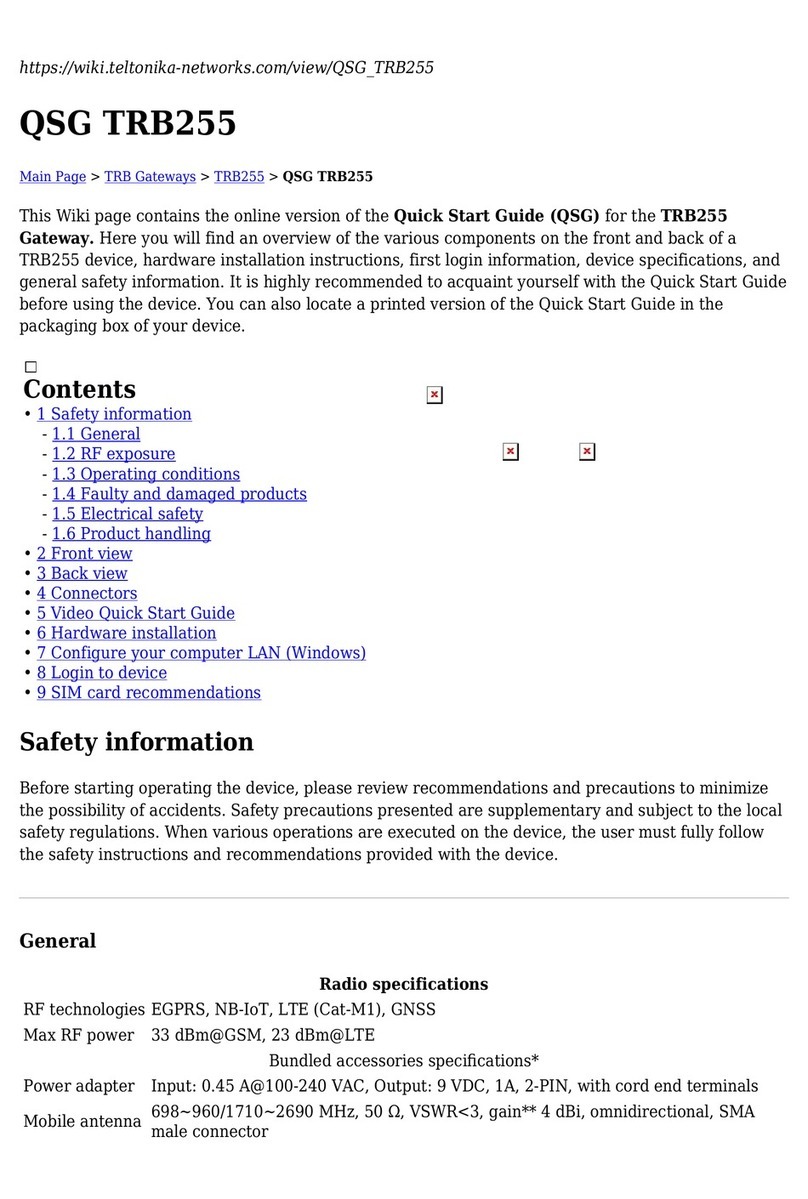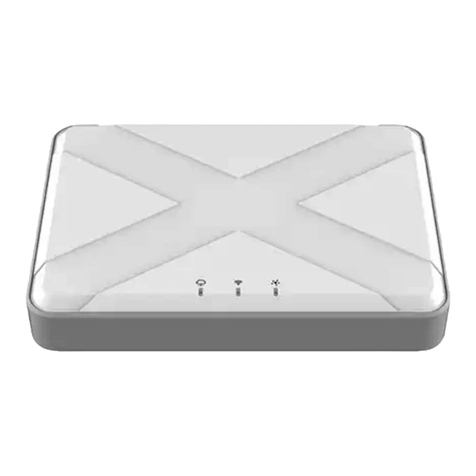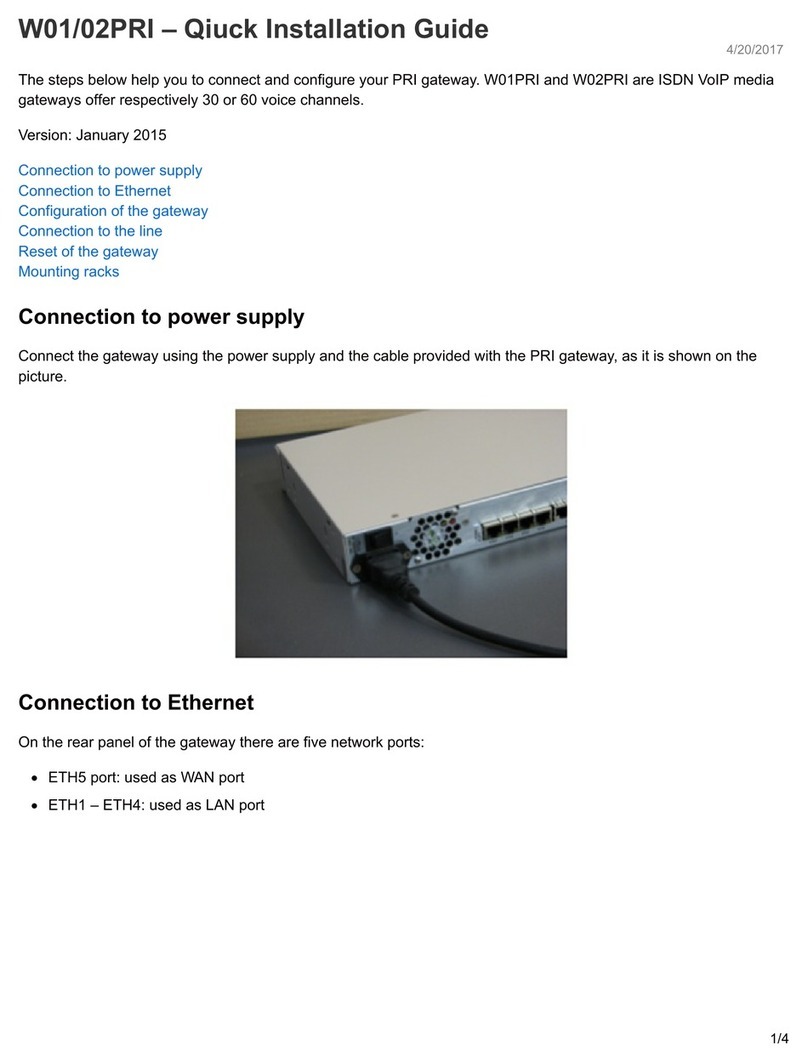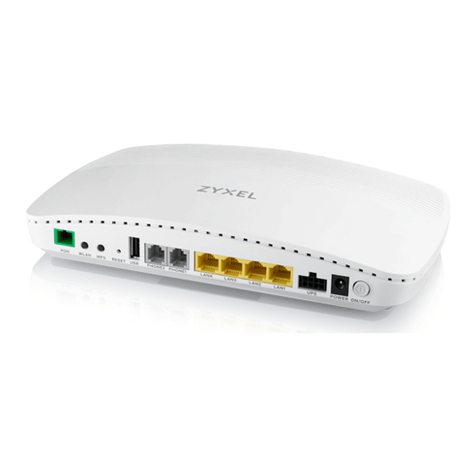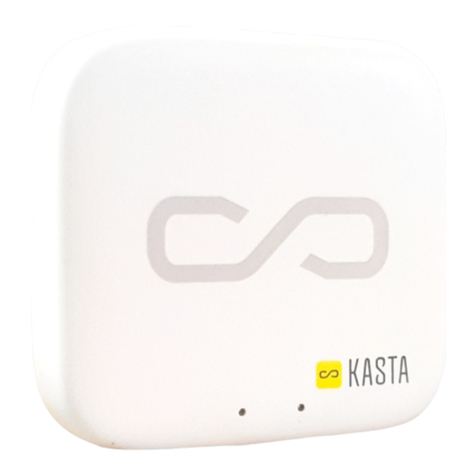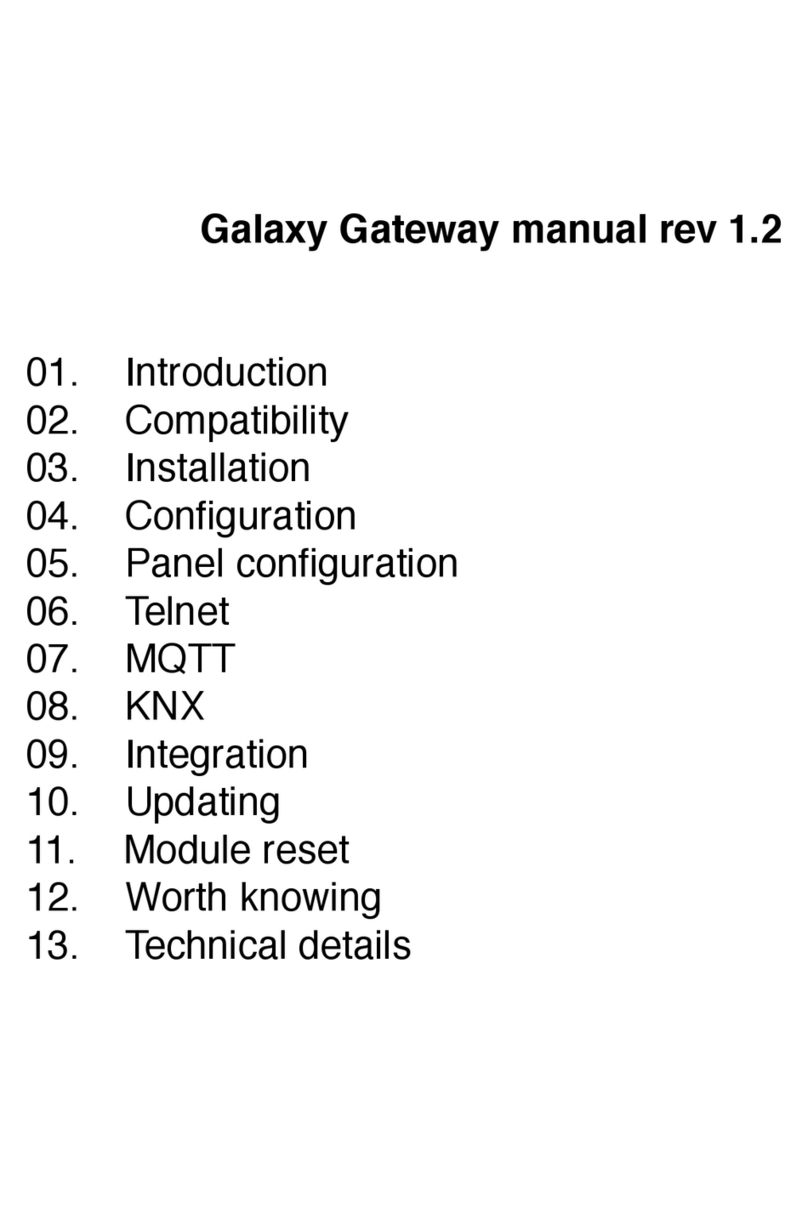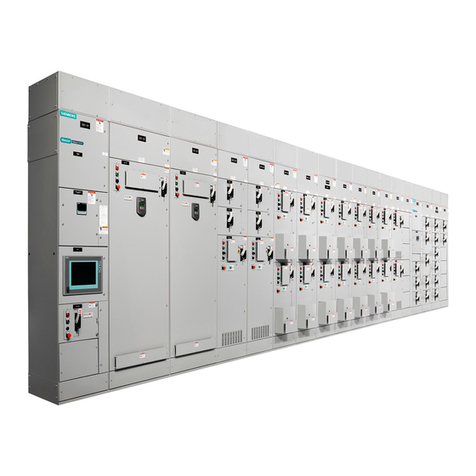Harmonic NSG 9000-3G Operation manual

NSG 9000
Universal EdgeQAM
HW and Installation User’s Guide
VERSION 1.5 & UP
NSG 9000-3G & bNSG 9000
Rev D

© 2011 Harmonic Inc. All rights reserved.
Disclaimer
Harmonic reserves the right to alter the equipment specifications and descriptions in this publication without prior notice. No part of
this publication shall be deemed to be part of any contract or warranty unless specifically incorporated by reference into such
contract or warranty. The information contained herein is merely descriptive in nature, and does not constitute a binding offer for
sale of the product described herein. Harmonic assumes no responsibility or liability arising from the use of the products described
herein, except as expressly agreed to in writing by Harmonic. The use and purchase of this product do not convey a license under
any patent rights, copyrights, trademark rights, or any intellectual property rights of Harmonic. Nothing hereunder constitutes a
representation or warranty that using any products in the manner described herein will not infringe any patents of third parties.
Trademark Acknowledgments
Harmonic and all Harmonic product names are trademarks of Harmonic Inc. All other trademarks are the property of their respective
owners.
Conventions
NOTE: The Note symbol calls your attention to additional information that you will benefit from
heeding. It may be used to call attention to an especially important piece of information you need, or it
may provide additional information that applies in only some carefully delineated circumstances.
TIP: The Tip symbol calls your attention to parenthetical information that is not necessary for performing
a given procedure, but which, if followed, might make the procedure or its subsequent steps easier,
smoother, or more efficient.
In addition to these symbols, this manual uses the following text conventions:
Data Entry: indicates text you enter at the keyboard.
User Interface: indicates a button to click, a menu item to select, or a key or key sequence
to press.
Screen Output: shows console output or other text that is displayed to you on a
computer screen.
Bold: indicates the definition of a new term.
Italics: used for emphasis, cross-references, and © 2011 Harmonic Inc.hyperlinked cross-
references in online documents.
Complimentary Documentation
Document Explanation
NSG 9000 Software Guide Describes the main features, configuration and alarms
of the NSG 9000 application.
bNSG 9000 Firmware Guide Describes the main features, initial configuration and
alarms of the bNSG 9000 application.

© 2011 Harmonic Inc. All rights reserved.
Revision History
Table 0-1: Revision History
Revision Date Description By
A May 2009 Creating document Tova
B October 2009 Corrections to table 1-1 Tova
C November 2009 Correction to table 1-12 Tova
D July 2011 Support of additional power supply Tova

© 2011 Harmonic Inc. 4 bNSG 9000 & NSG 9000-3G, Rev D
Preface
Table of Contents
Main Features and Specifications
1.1 Introduction . . . . . . . . . . . . . . . . . . . . . . . . . . . . . . . . . . . . . . . . . . . . . . . 6
1.2 Main Features . . . . . . . . . . . . . . . . . . . . . . . . . . . . . . . . . . . . . . . . . . . . . 6
1.3 NSG 9000 Physical and Power Specifications. . . . . . . . . . . . . . . . . . . 8
1.3.1 Physical Dimensions . . . . . . . . . . . . . . . . . . . . . . . . . . . . . . . . . . . . . . . 8
1.3.2 NSG 9000 Weight . . . . . . . . . . . . . . . . . . . . . . . . . . . . . . . . . . . . . . . . . 8
1.3.3 Power Supply Specifications . . . . . . . . . . . . . . . . . . . . . . . . . . . . . . . . . 8
1.3.4 Power Consumption from Grid . . . . . . . . . . . . . . . . . . . . . . . . . . . . . . . 9
1.3.5 Environmental Specifications . . . . . . . . . . . . . . . . . . . . . . . . . . . . . . . 10
1.4 Stream Processing Overview . . . . . . . . . . . . . . . . . . . . . . . . . . . . . . . . 10
1.5 NSG 9000 Front Panel . . . . . . . . . . . . . . . . . . . . . . . . . . . . . . . . . . . . . 11
1.5.1 Front Bezel . . . . . . . . . . . . . . . . . . . . . . . . . . . . . . . . . . . . . . . . . . . . . . 12
1.5.2 EIA-232 Serial Port . . . . . . . . . . . . . . . . . . . . . . . . . . . . . . . . . . . . . . . 12
1.5.3 Front Panel LEDs . . . . . . . . . . . . . . . . . . . . . . . . . . . . . . . . . . . . . . . . . 12
1.5.4 Control Panel . . . . . . . . . . . . . . . . . . . . . . . . . . . . . . . . . . . . . . . . . . . . 13
1.5.5 Air Inlets . . . . . . . . . . . . . . . . . . . . . . . . . . . . . . . . . . . . . . . . . . . . . . . . 13
1.5.6 Cooling Fans . . . . . . . . . . . . . . . . . . . . . . . . . . . . . . . . . . . . . . . . . . . . . 13
1.6 Back Panel . . . . . . . . . . . . . . . . . . . . . . . . . . . . . . . . . . . . . . . . . . . . . . . 13
1.6.1 Processing Module . . . . . . . . . . . . . . . . . . . . . . . . . . . . . . . . . . . . . . . 14
1.6.2 Module Slots . . . . . . . . . . . . . . . . . . . . . . . . . . . . . . . . . . . . . . . . . . . . . 17
1.6.3 Power Supply . . . . . . . . . . . . . . . . . . . . . . . . . . . . . . . . . . . . . . . . . . . . 18
1.6.4 What’s Next... . . . . . . . . . . . . . . . . . . . . . . . . . . . . . . . . . . . . . . . . . . . . 18
Installation
2.1 Unpacking the NSG 9000 Platform . . . . . . . . . . . . . . . . . . . . . . . . . . 19
2.2 Installing the NSG 9000 Platform . . . . . . . . . . . . . . . . . . . . . . . . . . . . 19
2.2.1 Rack Specifications . . . . . . . . . . . . . . . . . . . . . . . . . . . . . . . . . . . . . . . 19
2.2.2 Rack Ventilation . . . . . . . . . . . . . . . . . . . . . . . . . . . . . . . . . . . . . . . . . . 19
2.2.3 Rack Positioning and Device Mounting . . . . . . . . . . . . . . . . . . . . . . . 20
2.2.4 Rack Weight . . . . . . . . . . . . . . . . . . . . . . . . . . . . . . . . . . . . . . . . . . . . . 20
2.2.5 Power Source and Wiring Specifications . . . . . . . . . . . . . . . . . . . . . . 21
2.2.6 Facility Cooling Requirements . . . . . . . . . . . . . . . . . . . . . . . . . . . . . . 22
2.2.7 Required Tools for Installation . . . . . . . . . . . . . . . . . . . . . . . . . . . . . . 22
2.3 Inserting the Modules . . . . . . . . . . . . . . . . . . . . . . . . . . . . . . . . . . . . . . 22
2.3.1 Tools for Mounting/Replacing a Module . . . . . . . . . . . . . . . . . . . . . . 23
2.3.2 Installing a DTI Card (Optional) . . . . . . . . . . . . . . . . . . . . . . . . . . . . . . 24
Cabling
3.1 Device Dimensions . . . . . . . . . . . . . . . . . . . . . . . . . . . . . . . . . . . . . . . . 28
3.1.1 Back Panel Measurements . . . . . . . . . . . . . . . . . . . . . . . . . . . . . . . . . 28
3.2 Cabling the GbE Ports. . . . . . . . . . . . . . . . . . . . . . . . . . . . . . . . . . . . . . 29

Table of Contents
© 2011 Harmonic Inc. 5 bNSG 9000 & NSG 9000-3G, Rev D
3.2.1 Mirroring a GbE Input Port . . . . . . . . . . . . . . . . . . . . . . . . . . . . . . . . . 30
3.3 Connecting the QAM-RF Output Cables. . . . . . . . . . . . . . . . . . . . . . . 30
3.4 Connecting the ASI Monitoring Port Cables. . . . . . . . . . . . . . . . . . . . 30
3.5 Connecting the Ethernet Cables . . . . . . . . . . . . . . . . . . . . . . . . . . . . . 30
3.6 Cabling the DTI Card . . . . . . . . . . . . . . . . . . . . . . . . . . . . . . . . . . . . . . 31
3.7 Connecting Power. . . . . . . . . . . . . . . . . . . . . . . . . . . . . . . . . . . . . . . . . 31
3.7.1 Grounding the Mounted Devices . . . . . . . . . . . . . . . . . . . . . . . . . . . . 31
3.7.2 Connecting the AC Power Cable . . . . . . . . . . . . . . . . . . . . . . . . . . . . 31
3.7.3 Connecting the –48 VDC Power Supply . . . . . . . . . . . . . . . . . . . . . . 31
3.8 Establishing Ethernet Connection . . . . . . . . . . . . . . . . . . . . . . . . . . . . 32
3.8.1 What’s Next... . . . . . . . . . . . . . . . . . . . . . . . . . . . . . . . . . . . . . . . . . . . . 32
Maintenance
4.1 Cooling Fans Unit . . . . . . . . . . . . . . . . . . . . . . . . . . . . . . . . . . . . . . . . . 33
4.1.1 Removing and Replacing the Cooling Fans Unit . . . . . . . . . . . . . . . . 33
4.2 Hot Swapping Power Supply Unit . . . . . . . . . . . . . . . . . . . . . . . . . . . . 34

© 2011 Harmonic Inc. 6 bNSG 9000 & NSG 9000-3G, Rev D
Chapter 1
Main Features and Specifications
1.1 Introduction
This platform may operate as NSG 9000, a powerful Network Services GatewayTM or as
bNSG 9000, an augmented Broadcasting Network GatewayTM.
NOTE: NSG 9000 comes with either an AC power supply or –48 VDC power supply. All types of the NSG
9000 platform are intended to be installed in restricted access locations.
1.2 Main Features
The following table describes the main features of the NSG 9000 platform:
Table 1-1: Main Specifications
Component Feature Description
Chassis Chassis 2-RU, mounts in Electronic Industries
Association (EIA) standard rack
Chassis Hot-swappable
Front Panel
The front panel module includes four cooling
fans, LCD display panel and a keypad, and
indication LEDs. The module may be removed
for maintenance purposes while the system is
operational.
Chassis Indication LEDs 2 power, alarm and 9 output status LEDs.
Processing
module
6 x GbE input
ports (3 active & 3
backup)
Provides three independent ports receiving
simultaneously different feeds
Only three ports are simultaneously active,
see, 1.6.1.5 GbE Input Ports on page 15.
Input rate of up to 1000 Mbps per port
Processing
module
1 x ASI monitoring
port
ASI monitoring port can be configured to
output the same data as a selected QAM-RF
output TS. The ASI Port can be configured to
monitor any output TS.
Processing
module
Back panel LEDs Activity and alarm LED pair for each GbE port
(12 LEDs in all).
Processing
module
10Base-T/
100Base-T
Ethernet ports
Two independent Ethernet ports, typically used
for management (ETH1) and scrambling
(ETH2).
Processing
module
2xDTI ports
(optional)
Two DTI ports, typically used for M-CMTS
applications.

Chapter 1 Main Features and Specifications Main Features
© 2011 Harmonic Inc. 7 bNSG 9000 & NSG 9000-3G, Rev D
QAM-RF
module
Hot-swappable Up to 9 QAM-RF modules may be mounted in
the chassis. Modules may be added or
removed while the system is operational.
QAM-RF
modules
Up to nine QAM-
RF modules, with
2x QAM-RF ports
per module.
Overall, the
system includes
up to 18 QAM-RF
ports, capable of
carrying up to 72
QAM-RF channels
Each port carries up to four QAM channels
combined and upconverted. For further
information, refer to page 17.
QAM Mode:
ITU-T J.83 Annex-A (DVB): 8 MHz
ITU-T J.83 Annex-B: 6 MHz
ITU-T J.83 Annex-C (Japan): 6 MHz
QAM Constellations:
ITU-T J.83 Annex-A:16, 32, 64, 128, 256
ITU-T J.83 Annex-B: 64, 256
ITU-T J.83 Annex-C:16, 32, 64, 128, 256
For further QAM-RF specifications, see
product specification sheet.
QAM-RF
module
Maximum output
bit rate
ITU-T J.83 Annex-A
Up to 3xQAM channels per physical port
(Triple QAM)
Up to 6xQAM channels per module
Max output bitrate per QAM channel -
51.287 Mbps
ITU-T J.83 Annex-B:
Up to 4xQAM channels per physical port
(Quad QAM)
Up to 8xQAM channels per module
Max output bitrate per QAM channel -
38.811 Mbps
ITU-T J.83 Annex-C:
Up to 4xQAM channels per physical port
(Quad QAM)
Up to 8xQAM channels per module
Max output bitrate per QAM channel -
39.171 Mbps
Power Supply AC/DC Power
Supply Options
Two distinct types of Power Supply are
available: AC and DC. See 1.3.3 Power Supply
Specifications on page 8.
Power Supply Hot Swappable
redundant power
supply
Two independent Power Supply units may be
mounted in the chassis. The units can be
removed or inserted while the system is
operational.
Power Supply Current and load
sharing
When operating with two Power Supplies, load
is shared and balanced between the two
modules.
Table 1-1: Main Specifications
Component Feature Description

Chapter 1 Main Features and Specifications NSG 9000 Physical and Power Specifications
© 2011 Harmonic Inc. 8 bNSG 9000 & NSG 9000-3G, Rev D
1.3 NSG 9000 Physical and Power Specifications
1.3.1 Physical Dimensions
1.3.2 NSG 9000 Weight
1.3.3 Power Supply Specifications
Harmonic sells power supply units that have been thoroughly qualified to operate with the
NSG 9000-3G device. Tab le 1 –4 lists power specifications of a fully populated unit toghether
with the Harmonic part numbers for the qualified power supply modules. Use these part
numbers for ordering your power supply modules.
bNSG firmware version 1.2.1 and NSG9000-3G firmware version 1.6.6 and up, supports also
power supply units with the following part number: NSG-PS-AC-03, NSG-PS-DC-03, NSG-PS-
AC-03, NSG-PS-DC-03.
Table 1-2: Physical Dimensions
Dimension Inches mm
Height 3.47 88.1
Width 19.00 482.6
Total Length (front to back) 22.88 581.2
Depth (From rack mount fixture to
back of device)
21.78 553.4
Table 1-3: NSG 9000 Weight
Configuration Weight (lb.) Weight (kg)
Chassis 33.97 15.44
Power Supply (AC/DC) 3.95 1.80
QAM-RF blade 2.29 1.04
Full platform (chassis + 2xPS +
9xQRF)
62.48 28.4
Full platform, single PS
(chassis + 1xPS + 9xQRF)
58.53 26.6

Chapter 1 Main Features and Specifications NSG 9000 Physical and Power Specifications
© 2011 Harmonic Inc. 9 bNSG 9000 & NSG 9000-3G, Rev D
CAUTION: Both power supply units should be of the same part number. Power supply units with
different part numbers, may adversely affect the performance of the QAM-RF output signal.
1.3.4 Power Consumption from Grid
The following table lists the power consumtion from grid of a fully populated device and of a
single QAM-RF module. Use the consumption figure of a single module in order to calculate
the consumption of a partly-populated chassis:
For more details, see 2.2.5.2 Overcurrent protection on page 21.
Table 1–4: Power Supply Units Specifications
Harmonic Part
Number
PS
Type
Input Voltage
Range
Input Line
Frequency Comments
NSG-PS-AC-01 AC 85 to 264 VAC 47 to 63 Hz Supports up to 24 QAM channels per RF port
NSG-PS-DC-01 DC -36 to -72 VDC N/A Supports up to 24 QAM channels per RF port
NSG-PS-AC-02 AC 100 to240 VAC 47 to 63 Hz Supports up to 24 QAM channels per RF port
NSG-PS-DC-02 DC -40 to -60 VDC N/A Supports up to 24 QAM channels per RF port
NSG-PS-AC-03 AC 100 to240 VAC 47 to 63 Hz Supports up to 36 QAM channels per RF port
NSG-PS-DC-03 DC -40 to -60 VDC N/A Supports up to 36 QAM channels per RF port
Table 1-5: Power Consumption
Max Power Consumption from Grid(Watts)
Input
Voltage
Fully Populated
Chassis
Single QAM-RF
Module
110V AC 490 36
220V AC 480
48V DC 450

Chapter 1 Main Features and Specifications Stream Processing Overview
© 2011 Harmonic Inc. 10 bNSG 9000 & NSG 9000-3G, Rev D
1.3.5 Environmental Specifications
The following table lists the environmental specifications for the NSG 9000 (NSG-9K-CS-01):
1.4 Stream Processing Overview
The NSG 9000 accepts a GbE input, and outputs MPEG data over
QAM-RF signal. The following diagram shows the flow of data through the GbE channel.
NOTE: The diagram shows the flow of data via a single Quadruple
QAM-RF module. NSG 9000 may include up to 9 Quadruple QAM modules.
Table 1-6: Environmental Specifications
Parameter Description
Operating temperature 0 to 50 °C (32 to 122 °F)
Storage temperature –20 to 80 °C (–4 to 176 °F)
Relative humidity Maximum 95% non-condensing
Ventilation If units are installed in a closed rack, the rack must be
ventilated to ensure proper cooling of the units. Ventilation
rate must be:
At least 1.0 cubic meter per minute (35 cubic feet per
minute) per NSG 9000 unit.
Ventilation rate must be at least 2.2 M3/min (78 CFM) per
NSG 9000 unit. This is the air flow through the unit while fans
operate at full speed.

Chapter 1 Main Features and Specifications NSG 9000 Front Panel
© 2011 Harmonic Inc. 11 bNSG 9000 & NSG 9000-3G, Rev D
1.5 NSG 9000 Front Panel
The front panel of the NSG 9000 platform contains the following:
Front bezel
RS-232 connector
LEDs
Control panel
Four cooling fans
bNSG firmware version 1.2.1 and NSG9000-3G firmware version 1.6.6 support two types of
front panel:
NSG-FP-01-02F
NSG-FP-02-01F
The following figure illustrates front panel with part number NSG-FP-01-02F:

Chapter 1 Main Features and Specifications NSG 9000 Front Panel
© 2011 Harmonic Inc. 12 bNSG 9000 & NSG 9000-3G, Rev D
The following figure illustrates front panel with part number NSG-FP-02-01F. This front panel
comes with the Turbo indication to denote fans with higher speed:
1.5.1 Front Bezel
The NSG 9000 platform has a detachable front bezel that snaps on top of the control panel.
The air inlets located on the bezel provide air flow. See also, 1.5.5 Air Inlets on page 13.
1.5.2 EIA-232 Serial Port
The EIA-232 serial port may be used to configure the Ethernet port IP addresses. You can
use the serial port for monitoring and manual maintenance operations. The EIA-232 serial
port has a female DB-9 D-typ connector.
1.5.3 Front Panel LEDs
The front panel of the NSG 9000 platform includes the following LEDs:
Output Modules LEDs - nine LEDs for monitoring the status of the modules.
Operation Status LEDs - include two Power supply LEDs and an Alarm LED. The
Operation Status LEDs enable to monitor the status of the NSG 9000 power and of the
unit’s operation. The LEDs function the same in both standalone and NMX control
modes. The following table describes the front panel LEDs, from left to right and from top
down.
Serial port Front panel LEDs Control panel with
keys
Air inlets
Turbo indication
Serial port Front panel LEDs Control panel with
keys
Air inlets

Chapter 1 Main Features and Specifications Back Panel
© 2011 Harmonic Inc. 13 bNSG 9000 & NSG 9000-3G, Rev D
1.5.4 Control Panel
The control panel consists of an LCD display area and a keypad. The control panel enables
preliminary configuration and basic monitoring of the device. It is usually used for standalone
devices. For further information, see NSG 9000 Software User’s Guide or bNSG 9000
Firmware User’s Guide.
1.5.5 Air Inlets
Air inlets are located along the lower, upper right and middle of the front panel. The air inlets
are designed to provide maximum air flow. The air flow is critical for maintaining the proper
temperature range. Fans in the front unit draw air in through the front inlets.
CAUTION: Do not obstruct the airflow when mounting the device on the rack. Severe equipment
damage can result when the device cannot properly exhaust the airflow.
1.5.6 Cooling Fans
The NSG 9000 platform uses four fans to control the temperature during operation. The fans
located in the front of the device, use air from the front and exhaust it to the rear of the
device. Each fan has a speed control and the CPU manages their speed to increase Mean
time Between Failures and to lower the noise level.
All four fans are mounted on the back side of the front panel to allow a quick and easy hot
swap in case of a fan failure. For further information, refer to 1.5.6 Cooling Fans on page 13.
1.6 Back Panel
This section describes the back panel of the NSG 9000 platform. The back panel of the NSG
9000 platform includes the following:
Processing module
9 x Module Slots
2 x Power supply
Table 1-7: Frot Panel LEDs
LED Color Description
Power PS1 and
PS2
Green/Red ON (Green) - Power supply unit is working
properly.
ON (Red) - Power supply unit is faulty.
OFF - Power supply unit is not mounted in the
slot.
Alarm Red/Orange ON (Red) - Indicates an alarm has been
activated in the device. Refer to NSG 9000
Software User’s Guide for further details.
OFF - Indicates no alarm activated.
Module 1 - 9 Green/Red/Orange ON (Green) - A module is mounted and it is
working properly.
ON (Red) - A module is mounted and is faulty.
OFF - No module is mounted.

Chapter 1 Main Features and Specifications Back Panel
© 2011 Harmonic Inc. 14 bNSG 9000 & NSG 9000-3G, Rev D
Grounding terminal
1.6.1 Processing Module
The Processing module is the main module of the NSG 9000 platform. It includes the
communication interfaces of the unit and the GbE interfaces. The Processing module
manages, configures and monitors the device and its modules. It is a swappable module that
is easily mounted from the rear side of the platform. The Central Processing module includes
the following components:
Ethernet ports
2 x DTI ports for M-CMTS application (optional)
1 x Clock Test port for future use only
ASI Monitor port
Module map
JTAG - for servicing the device
6 x GbE port
NOTE: In case of processing module malfunction, replace the module as instructed in 2.3 Inserting the
Modules on page 22 and send the faulty module to Harmonic.
1.6.1.1 Ethernet Ports
Ethernet ports - allow connection to separate networks. The Ethernet ports are labeled ETH1
and ETH2. ETH1 is a management port and ETH2 is for future use. Both ports are 10/100
Base-T ports. For cabling instructions, see 3.5 Connecting the Ethernet Cables on page 30.
Processing module 9 x populated Module slots 2 x Power supply Grounding
terminal
2 x Ethernet
ports
2 x DTI ports
(optional)
Clock Test
port
ASI monitor
port
6 x GbE ports

Chapter 1 Main Features and Specifications Back Panel
© 2011 Harmonic Inc. 15 bNSG 9000 & NSG 9000-3G, Rev D
1.6.1.2 DTI Ports
The DTI ports, labeled DTI1 and DTI2, are optional and are operating once a DTI card is
installed. The latter is installed when the NSG 9000 device is operating in an M-CMTS
application. You may purchase a device with the DTI card installed or install it by yourself. For
installation and cabling instructions, see 2.3.2 Installing a DTI Card (Optional) on page 24.
The following table lists the DTI ports specifications:
1.6.1.3 ASI Monitoring Port
The NSG 9000 platform may duplicate one of the output transport streams to the ASI output
port designed for monitoring purposes. Use this port to connect to devices that accept ASI
input such as an MPEG analyzer. For cabling instructions, see 3.4 Connecting the ASI
Monitoring Port Cables on page 30.
1.6.1.4 Module Map
The Module Map is a graphic view of the back panel of the device for ease of use.
1.6.1.5 GbE Input Ports
The NSG 9000 platform includes six GbE ports labeled GbE 1- 3 and
GbE 1 - 3. Three ports support Small Form Factor Pluggable (SFP) transreceivers for either
fiber or copper cables and the other three support copper cables for 1000 Base-T cables
only.
Any combination of active ports is supported except for the following:
Copper #1 & SFP #1
Copper #2 & SFP #2
Copper #3 & SFP #3
The following table lists the GbE port specification:
Table 1-8: DTI Ports Specifications
Parameter Specification
Input signal Complies with DOCSIS 3.0 DTI
Table 1-9: GbE Port Specifications
Parameter Specification
Connector Three receptacles for SFP connectors
RJ-45 connector
Maximum input bitrate n Line rate up to 1000 Mbps
n Processing up to
Maintenance Swappable

Chapter 1 Main Features and Specifications Back Panel
© 2011 Harmonic Inc. 16 bNSG 9000 & NSG 9000-3G, Rev D
The NSG 9000 back panel features two LEDs for each GbE port. The following table
describes the LEDs:
1.6.1.6 SFP Module
The SFP (Small Form Factor Pluggable) module converts optical data into electrical data and
vice versa. The SFP modules allow the NSG to receive input signals over a variety of physical
interfaces:
Single-mode optical interface (1000 Base-LX)
Multi-mode optical interface (1000 Base-SX)
Copper interface (1000 Base-T)
The following figure illustrates an SFP module:
Warning: Class I laser product. (IEC/EN 60825-1; 21CFR SubChapter J (1040.10 and
1040.11)
You can use either of the following types of SFP depending on the cable/fiber type you are
using.
Harmonic sells SFP modules that have been thoroughly qualified to operate with the NSG
9000 device. These SFPs are made by Finisar, and may be purchased either directly from
Harmonic, or from other sources.
Table 1-11 on page 17 lists the Harmonic part numbers for the qualified SFP modules, as well
as the matching Finisar part numbers for the same modules. Use these part numbers for
ordering your SFP modules.
Table 1-10: LEDs of GbE Ports
LED Color Description
Activity Green
Blinking green
Illuminates when a live fiber is connected
and a network link is detected.
Blinking when real traffic flows through the
link.
Error Yellow Illuminates when an alarm is issued
Off when port is inactive or no alarm has
been issued.
SFP copper
SFP fiber

Chapter 1 Main Features and Specifications Back Panel
© 2011 Harmonic Inc. 17 bNSG 9000 & NSG 9000-3G, Rev D
NOTE: To be eligible for support by Harmonic, use qualified SFPs only.
An optical SFP has two LC sockets, Receive(Rx) and Transmit(Tx). Use Multimode or
Singlemode fiber optics to connect your Gigabit Ethernet switch to the Rx socket. If bi-
directional topology is used, connect the Tx socket back to the switch.
1.6.2 Module Slots
The back panel of the NSG 9000 platform includes nine module slots labeled Module 1 to
nine. Each one of the slots accommodates a single QAM-RF module. The following figure
illustrates the arrangement of the slots at the back panel of the device:
1.6.2.1 QAM-RF Modules
Each QAM-RF module performs QAM modulation and up conversion of the QAM signal. Each
QAM-RF module includes two QAM-RF ports labeled 1 and 2. Each port may output up to
four channels as your license permits. For further details refer to the NSG 9000 Online Help
or to the NSG 9000 SW User’s Guide and for bNSG to NMX Online Help.
The following table provides the RF port specifications:
Table 1-11: SFP Modules
Harmonic Part
Num. Fiber/Cable Type Connector
Type
Wave
Length
Max. Cable/
Fiber Length
Qualified Finisar SFP
Model Part Num.
GSF9311-02 Multimode fiber 2 x LC 850 nm 550m FTLF8519P2BNL
GSF9322-02 Singlemode fiber 2 x LC 1310 nm 10 km FTLF1319P1BTL
GSF9132-02 Singlemode fiber 2 x LC 1550 nm 70 km FTLF1621P2BCL
GSF9100-02 Shielded and
grounded CAT-6 or
CAT-7
1 x RJ-45 N/A 100m FCLF-8521-3
Table 1-12: RF Port Specifications
Parameter Description
Connector Male F connector
Cable RG-6 only

Chapter 1 Main Features and Specifications Back Panel
© 2011 Harmonic Inc. 18 bNSG 9000 & NSG 9000-3G, Rev D
NOTE: For detailed specifications, see NSG 9000 data sheet.
Each module may be configured offline and when mounted into the slot, the system identifies
the inserted module. The modules are hot swappable and are mounted and plugged from the
rear side of the device.
For information on how to connect the ports, see3.3 Connecting the QAM-RF Output Cables
on page 30.
1.6.3 Power Supply
The NSG 9000 device is furnished with two hot swappable redundant AC or DC power
supply units. Each power supply unit easily accommodates the power consumption of a fully
populated device. When both power supply units are plugged in and connected to the mains,
the power supply units operate in current sharing mode. For power consumption
specifications, see 1.3.3 Power Supply Specifications on page 8.
The physical dimensions of the AC/DC power supply are: 40mmH x 90mmW x 440mmD.
Each power supply unit features two LEDs. The following table describes the LEDs:
For instructions to connect the AC power supply, see 3.7 Connecting Power on page 31. For
overcurrent protection see 2.2.5.2 Overcurrent protection on page 21.
The -48 VDC power supply unit is supplied with the required 3-pin male connector. See
Wiring the –48 VDC Power Supply on page 36 for instructions to connect the power supply.
NOTE: Consideration should be given to the connection of the equipment to the supply circuit and the
effect that overloading of circuits might have on overcurrent protection and supply wiring. Appropriate
consideration of equipment nameplate ratings should be used when addressing this concern.
1.6.4 What’s Next...
The next step is to unpack and cable the NSG 9000 platform, as described in the following
chapter.
Output center frequency ANNEX A 54 - 866MHz
ANNEX B 53 - 867MHz
LED Color Description
In Ok Green Illuminates when mains input voltage is
present.
Out Ok Green Illuminates when output voltage is greater
than 80% of the nominal output rate.
Table 1-12: RF Port Specifications
Parameter Description

© 2011 Harmonic Inc. 19 bNSG 9000 & NSG 9000-3G, Rev D
Chapter 2
Installation
This chapter instructs you on how to install the NSG 9000 device. For best results, perform
the required actions according to following order:
“Unpacking the NSG 9000 Platform” on page 23
“Installing the NSG 9000 Platform” on page 24
“Inserting the Modules” on page 29
“Installing a DTI Card (Optional)” on page 32
“Connecting Power” on page 42
2.1 Unpacking the NSG 9000 Platform
The NSG 9000 platform comes in a specially designed shipping container that ensures its
safety during shipping and handling. To avoid damaging the NSG 9000 platform, unpack it
carefully. The container includes the following:
Chassis - front panel is attached but no modules are mounted
Processing module - the module is static sensitive. Unpack, following the ESD guidelines
on 2.3 Inserting the Modules on page 22.
The QAM-RF modules and power supply units are shipped separately.
2.2 Installing the NSG 9000 Platform
NOTE: The NSG 9000 platforms are used in restricted access locations.
NOTE: To prevent body injury when mounting or servicing this platform in a rack, you must take special
precautions to ensure that the system remains stable. Read the following guidelines to assure your safety.
2.2.1 Rack Specifications
Install the 2-RU chassis in the following rack:
a standard EIA 19-inch computer rack with at least 30” (76cm) depth.
To allow free air flow, the rack must be completely open at its front side.
The rack should be mounted with side walls and a back door.
The back door should have ventilation slots at its bottom part.
The top of the rack should be closed and mounted with cooling fan(s). For fan
requirements, see following section.
2.2.2 Rack Ventilation
Each NSG 9000 unit requires ventilation of at least 2.2 M3\min (78 CFM). Calculate the
total required M3\min or CFM accordingly. In case devices of another type are mounted
on the rack, consider their cooling requirements as well.
For example, the combined air flow of fans mounted at the top of a rack mounted with ten
NSG 9000 devices is at least 22.7 M3/min (780 CFM).

Chapter 2 Installation Installing the NSG 9000 Platform
© 2011 Harmonic Inc. 20 bNSG 9000 & NSG 9000-3G, Rev D
2.2.3 Rack Positioning and Device Mounting
2.2.3.1 Rack positioning
From front - leave clearance of at least 25”(63cm) from the front to any neighboring
cabinet/wall.
From back - leave clearance of at least 20”(51cm) from the back to any neighboring
cabinet/wall.
2.2.3.2 Device Mounting
The following table lists the guidelines and specifications for mounting the NSG 9000 devices
on a rack:
NOTE: Do not obstruct the airflow of the platform. Severe equipment damage can result when the
device cannot properly exhaust the airflow.
2.2.4 Rack Weight
1. Check the allowed floor load of the facility.
2. Calculate the total weight and load according to the following parameters:
3. Limit the number of NSG 9000 devices on a rack according to the allowed floor load.
Take into account also additional equipment to be mounted on the rack.
Parameter Description
Occupied Space 2 rack unit
Mounting Order Partially filled rack - load rack from the bottom to the top with the
heaviest component at the bottom of the rack.
Max Number According to allowed floor load. See, 2.2.4 Rack Weight on
page 20.
Spacing between units (1RU or more) is recommended for ease of
cabling. Block the spaces between units as explained in this table
in “Open space”.
Mounting Method Mount each device on supporting rails provided by Harmonic in a
separate kit (P/N RM-4-30). Install the rack-mounting rails before
mounting the device on the rack.
Open space To prevent hot air circulation:
All open spaces below and above the devices should be
closed with a blank panel.
Cabling Route all cables at the back panel along the sides of the rack to
allow pulling out the power supply unit and QAM-RF modules.
Table 2-1: Rack Weight
Item Value (US) Value (metric)
Single fully loaded NSG 9000 unit 58.53 lbs 26.6 Kg
Footprint of a typical 23"x30" rack 4.8 sqr. Ft 0.446 m2
This manual suits for next models
2
Table of contents
Other Harmonic Gateway manuals
Popular Gateway manuals by other brands

RTA
RTA 460BMTCP-NNA1 Product user guide
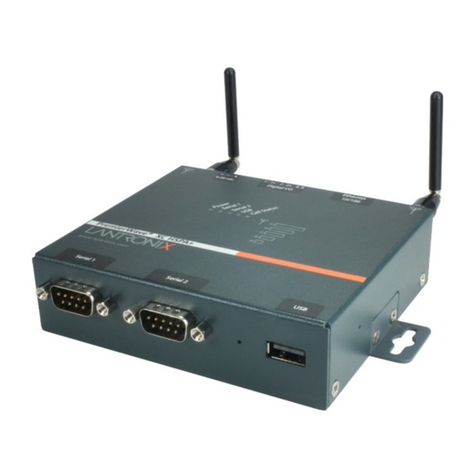
Lantronix
Lantronix PREMIERWAVE XC HSPA+ user guide
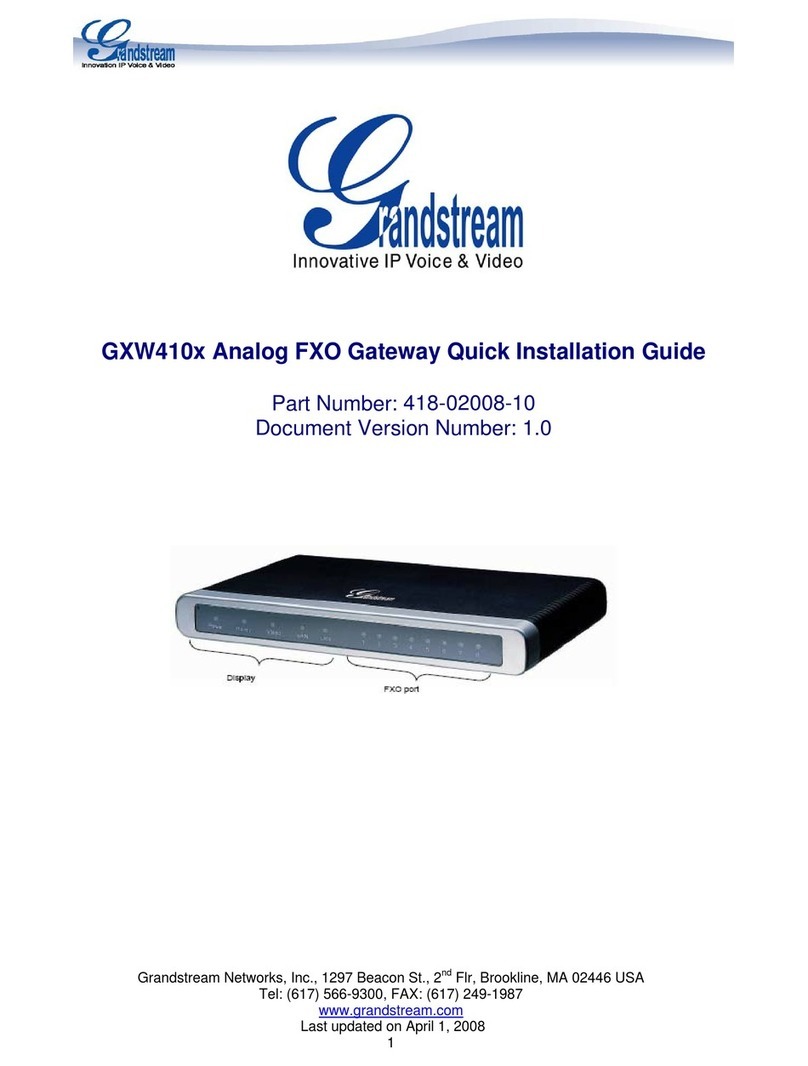
Grandstream Networks
Grandstream Networks GXW-410x Quick installation guide
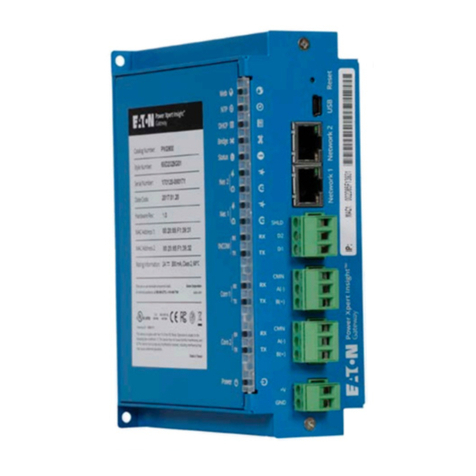
Eaton
Eaton Power Xpert Gateway 900 quick start guide
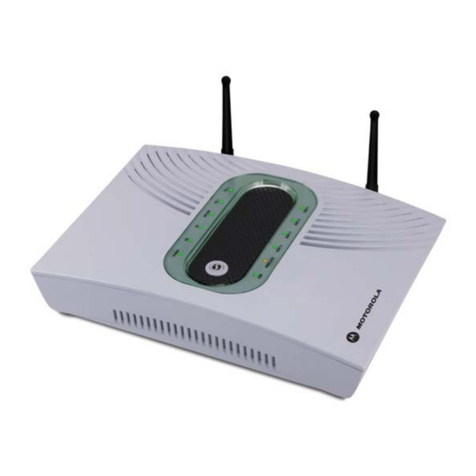
Motorola
Motorola SURFboard SVG2500 Quick installation guide
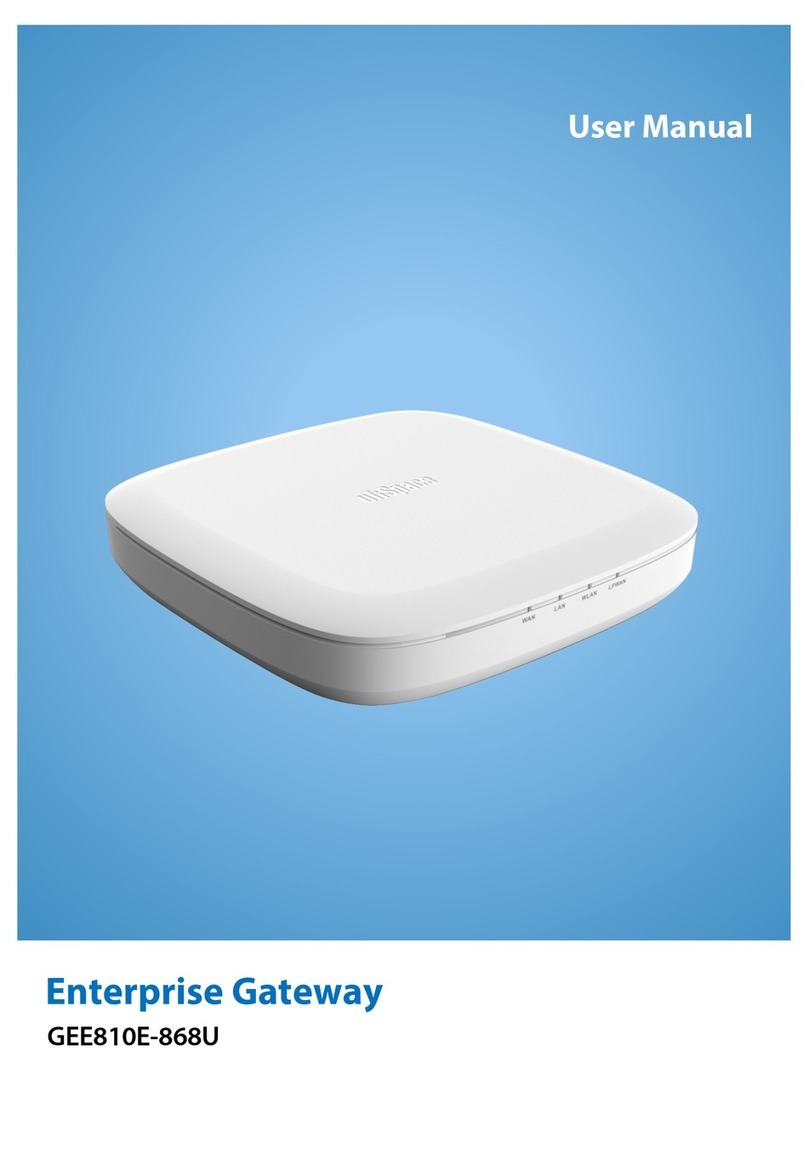
UfiSpace
UfiSpace GEE810E-868U user manual

